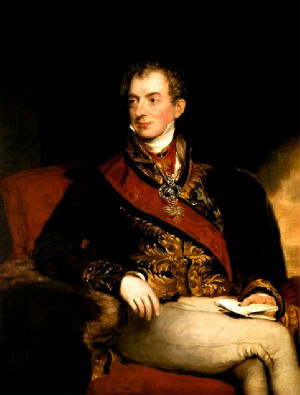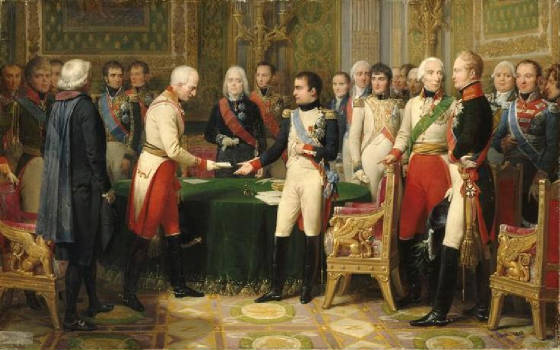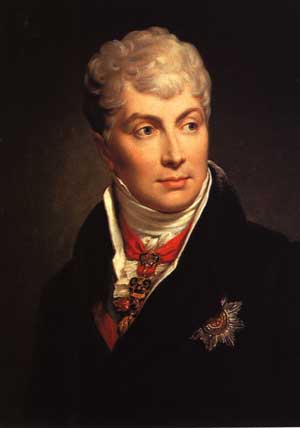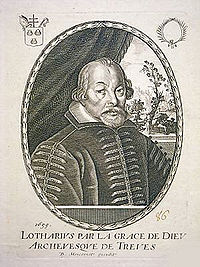|
Mediatized House of Metternich
House of Metternich-Winneburg The
House of Metternich is a German noble house originating in Rhineland. The most prominent member of the House of Metternich
was Klemens von Metternich, who was the dominant figure at the Congress of Vienna (1814-1815). Background of the House of MetternichThe House of Metternich originated as a cadet
branch of the rulers of Hemmerich (which today is a district of Bornheim, near Bonn). The head of
the family rose to have the position of hereditary chamberlain of the Archbishop of Cologne. This branch of
the family drew its name from the village of Metternich in Weilerswist beginning in the 13th century. By the 16th century, the family had seven distinct branches: - Metternich-Burscheid
- Metternich-Winneburg
- Metternich-Chursdorf
- a
branch in Lorraine
- a branch in the Duchy
of Jülich
- a second branch in the Duchy of Jülich
Metternich-Chursdorf A second line of the family, founded by Johann Reinhard Freiherr von Metternich, came to rule Chursdorf. This branch
of the family converted to the Protestant faith. Johann Reinhard Freiherr von Metternich's son Ernst von Metternich, made
a Graf in 1697, was a soldier in the service of Frederick I of Prussia and a member of the privy council of Brandenburg-Prussia.
Ernst von Metternich was involved in the diplomacy that saw Frederick I granted the title King in Prussia, in Prussia's acquisition
of Neuchâtel, and in the negotiating of the Treaty of Utrecht in 1713. Ernst von Metternich's brother was a member of
the privy council of the Principality of Ansbach and in 1726 became Chancellor of Schwarzburg. He was also an author on questions
of theosophy and alchemy. Metternich-Winneburg-Beilstein Lothar von Metternich (1551-1623) - Archbishop of Trier Klemens
von Metternich (1773-1859) Princess
Pauline von Metternich (1836-1921) In 1635, the family of Archbishop of Trier Lothar Johann Reinhard
von Metternich (1515-1623) acquired the County of Beilstein and began styling themselves Freiherren von Metternich-Winneburg
zu Beilstein. Their title was upgraded to Graf in 1679. Lothar Johann Reinhard von Metternich's nephews, Karl von Metternich
and Emmerich von Metternich, were opposed to the policies of Archbishop of Trier Philipp Christoph von Sötern. In
1623-30, the Imperial Quartermaster General, Lothar von Metternich and his brother Wilhelm purchased the lordships of Lázně
Kynžvart and the village of Metternich near Koblenz. Wilhelm's eldest son Karl Heinrich von Metternich-Winneburg was
Archbishop of Mainz and Bishop of Worms in 1679. The younger son, Philip Emmerich von Metternich (d. 1698), was raised to
the rank of Graf. The last Count of Metternich-Winneburg was Franz Georg Carl Joseph Johann Nepomuk von Metternich-Winneburg,
who lost the County to France by the 1801 Treaty of Lunéville. In compensation, Francis II, Holy Roman Emperor gave
him the secularized Ochsenhausen Abbey and raised him to the rank of Fürst. His son, Klemens von Metternich
worked in the service of the Austrian Empire; he was a major diplomat at the Congress of Vienna and was Minister-President
of Austria from 1821 to 1848. He acquired Schloss Johannisberg in the Rheingau. His son, Richard von Metternich was married to his niece, Princess
Pauline von Metternich (Pauline was the daughter of Klemens' half-sister Leonore). Richard and Pauline von
Metternich had three daughters, but no sons, so upon the death of Richard, the title of Fürst passed to Richard's half-brother
Paul von Metternich (1834-1906). The title then passed to his son, Klemens Wenzel von Metternich (1869-1930). His son, Paul
Alfons von Metternich-Winneburg (1917-1992) was the president of ADAC. In 1992, the title of Fürst passed to Franz Albrecht
Metternich-Sándor (1920-2009), whose mother was a descendant of Klemens von Metternich and who had been adopted by
his aunt Clementine von Metternich-Sándor (1870-1963). Franz Albrecht Metternich-Sándor the son of Victor III,
Duke of Ratibor and Prince of Corvey, and also inherited his father's title. Franz Albrecht's eldest son is Viktor Metternich-Sándor
(b. 1964), who has headed the House of Metternich since his father's death. Elevations of Rank- Freiherr -
granted to Wolfgang Heinrich von Metternich on April 14, 1664
- Graf - granted to Philipp Emmerich Freiherr von Metternich-Winneburg on March 20, 1667
- Graf - granted to Ernst Freiherr von Metternich-Chursdorf on May 28, 1696
- Fürst - granted to Franz Georg Carl Joseph Johann Nepomuk von Metternich-Winneburg
on June 30, 1803
- Extension of Austrian hereditary
princedom to descendants of Franz Georg Carl Joseph Johann Nepomuk von Metternich-Winneburg - granted on October 20, 1813
- Duke of the Kingdom of Naples - granted to Klemens von Metternich on
August 1, 1818
Prominent
Members of the House of Metternich- Lothar Johann Reinhard
von Metternich (1551-1623), Archbishop and Elector of Trier
- Johann Reinhard Freiherr von Metternich, Protestant administrator of the pin Halberstadt.
- Johann Burchard von Metternich († 1637), canon of Trier, Bamberg and Münster,
provost of Mainz, Magdeburg and administrator of Halberstadt and provost of St. Bartholomew in Frankfurt am Main
- Karl von Metternich († 1635), canon of Trier, Liège, Eichstätt and Augsburg,
archdeacon of St. Kastor in carding and provost of Aachen Cathedral
- Emmerich von Metternich († 1653), Canon in Trier, Worms, and Paderborn and provost in Trier
- Lothar von Metternich († 1663), Imperial Chamberlain, Privy Councillor, Colonel and
Quartermaster General
- Wilhelm von Metternich (†
1652), of imperial court and council of war
- Heinrich
von Metternich zu Brohl († 1654), first minister later soldier, governor of the occupied lower Palatinate of Bavaria
and Major General
- Lothar Friedrich von Metternich-Burscheid (1617-1675), Archbishop
of Mainz
- Karl Heinrich von Metternich-Winneburg (1622-1679),
Archbishop of Mainz
- Ernst von Metternich (1656-1727),
Prussian diplomat
- Wolfgang von Metternich (†
1731), diplomat, civil servant and alchemical writer
- Franz
Georg Karl von Metternich (1746-1818), politician
- Klemens
von Metternich (1773-1859), Austrian diplomat and politician
- Richard von Metternich (1829-1895), Austrian politician and diplomat
- Princess Pauline von Metternich (1836-1921), founder of a literary salon in Vienna
- Tatiana von Metternich-Winneburg (1915-2006), patron
- Paul Alfons von Metternich-Winneburg (de) (1917-1992)
- Franz-Albrecht Metternich-Sándor (1920-2009), head of the ducal line Ratibor-Corvey,
princely house of Hohenlohe-Schillingsfürst
- Viktor
Metternich-Sándor, born 1964, since 2009 head of the ducal line Ratibor-Corvey princely house of Hohenlohe-Schillingsfürst
- Reinhard Carl Johann von Metternich-Runge, born 1965, Philanthropist and Human Rights Activist
 Klemens von Metternich Prince Klemens Wenzel von Metternich (full name German: Klemens Wenzel
Nepomuk Lothar, Fürst von Metternich-Winneburg zu Beilstein, anglicised as Clement Wenceslas Lothar von Metternich-Winneburg-Beilstein;
15 May 1773 - 11 June 1859) was a German-born Austrian politician and statesman and one of the most important diplomats of
his era, serving as the Foreign Minister of the Holy Roman Empire and its successor state, the Austrian Empire, from 1809
until the liberal revolutions of 1848 forced his resignation. One of his first tasks was to engineer a détente with
France that included the marriage of Napoleon to the Austrian Arch-Duchess Marie Louise. Soon after, however, he engineered
Austria's entry into the War of the Sixth Coalition on the Allied side, signed the Treaty of Fontainebleu that sent Napoleon
into exile and led the Austrian delegation at the Congress of Vienna which divided post-Napoleonic Europe between the major
powers. In recognition of his service to the Austrian Empire he was raised to the title of Prince in October 1813. Under his
guidance, the "Metternich system" of international congresses continued for another decade as Austria aligned herself
with Russia and, to a lesser extent, Prussia. This marked the high point of Austria's diplomatic importance, and thereafter
Metternich slowly slipped back into the periphery of international diplomacy. At home, Metternich also held the post of Chancellor
of State from 1821 until 1848, under both Francis II of Austria and his son Ferdinand I of Austria. After a brief period of
exile in London, Brighton and Brussels that lasted until 1851, he returned once more to the Viennese court, this time to offer
only advice to Ferdinand's successor, Franz Josef. Having outlived his generation of politicians, Metternich died at the age
of 86 in 1859.  Born into the House of Metternich in 1773 as the
son of a diplomat, Metternich received a good education at the universities of Strasbourg and Mainz. He also helped during
the coronation of Francis II in 1792 and that of his predecessor, Leopold II, in 1790. After a brief trip to England, Metternich
was named as the Austrian ambassador to the Netherlands; a short-lived post, since the country was brought under French control
the next year. He married his first wife, Eleonore von Kaunitz, in 1795 and it did much to catapult him into Viennese society.
Despite having numerous affairs, he was devastated by her death in 1825. He would later remarry, wedding Baroness Antoinette
Leykam in 1827 and, after her death in 1829, Countess Melanie Zichy-Ferraris in 1831. She would also predecease him by five
years. Before taking office as Foreign Minister, Metternich held numerous smaller posts, including ambassadorial roles in
the Kingdom of Saxony, the Kingdom of Prussia and Napoleonic France. One of Metternich's sons, Richard von Metternich, was
also a successful diplomat; many of Metternich's twelve other acknowledged children predeceased him. A traditional conservative,
Metternich was keen to maintain the balance of power, in particular by resisting Russian territorial ambitions in Central
Europe and over the lands of the Ottoman Empire. He disliked liberalism and worked to prevent the breakup of the Austrian
empire; for example, by forcibly crushing nationalist revolts in Austrian north Italy and the German states. At home, he pursued
a similar policy, using censorship and a wide ranging spy network to dampen down unrest.  Metternich has both been praised and heavily criticised
for the policies he pursued. His supporters point out that he presided over the "Age of Metternich", when international
diplomacy helped prevent major wars in Europe. His qualities as a diplomat have also been commended; some add that his achievements
were all the better given the weakness of his negotiating position. His decision to oppose Russian imperialism is also seen
as a good one. His detractors describe him as a bore who stuck to ill-thought out conservative principles only out of vanity
and a sense of infallibility. They argue that he could have done much more in terms of securing Austria's future; instead,
his 1817 proposals for administrative reform were largely rejected and, by opposing German nationalism, they find him responsible
for ensuring it would be Prussia and not Austria that united it. Other historians have argued that in fact he had far less
power than this view suggests, and that his policies were only accepted when they agreed with the existing view of the Habsburg
monarchy that ruled Austria.  The Titles and Styles of the Princely House
The members of this family bore
the titles of Prince or Princess von Metternich-Winneburg together with the formal appellation of His or Her Serene Highness
The Genealogy of The Princely House Wilhelm, cr 1635 Frhr von Metternich, von Winneburg
und Beilstein (d.1652); m.1st 5 Jun 1610 Anna Ursula von Hattstein; m.2d 12 May 1619 Anna Eleonora Brömser von Rüdesheim
(test 1658) [by 1st m.]: 1a) Johann Ludwig (d.aged 20) 2a) Lothar Friedrich,
a canon in Mainz and Trier (1627) [by 2d m.]: 3a) Karl Heinrich, Elector of Mainz, Pr-Bp of Worms
1679 (15 Jul 1622-26 Sep 1679)
4a) Philipp Emmerich cr 1679 Gf von Metternich-Winneburg und Beilstein, d.6 Mar
1698; m.1st 14 Feb 1652 Marie Elisabeth Magdalena Frn Waldbott von Bassenheim (d.1685); m.2d Anna Theresia Cukr von Damfeld
(d.1713); all issue by 1st m.
1b) Franz Ferdinand (1653-14/15 Jun 1719); m.1683 Juliane Eleonore Gfn von Leiningen-Westerburg
(14 Dec 1667-Dec 1742)
1c) Philipp Adolf (d.1693)
2c) Franz Philipp Emmerich
3c) Dietrich Philipp Adolf (1686-19 Dec
1739); m.21 Sep 1707 Marie Franziska Frn Schenk von Schmittburg (d.23/27 Nov 1723)
1d) Franz Ludwig (9 Feb 1719-4
Jun 1778)
2d) Johann Hugo Franz (28 Sep 1710-24 Mar 1750); m.1st 28 Apr 1745 Klara Luise Elisabeth Frn von Kesselstatt
(18 Nov 1726-26 May 1746); m.2d 15 Oct 1747 Maria Theresia Gfn von Hoensbroech (bap 7 Mar 1728-11 Aug 1800)
1e)
FRANZ GEORG Karl Joseph Johann Nepomuck Graf von Metternich-Winneburg, cr 1803 Fst von Metternich-Winneburg und Ochsenhausen
(Koblenz 9 Mar 1746-Vienna 11 Aug 1818); m.Freiburg 9 Jan 1771 Maria Beatrix Aloysia Gfn von Kageneck (Freiburg 8 Dec 1755-Vienna
23 Nov 1828)
1f) Kunigunde Walpurga Pauline, cr Pss 1817 (Koblenz 29 Nov 1771-Vienna-Hietzing 23 Jun 1855); m.Marseilles
23 Feb 1817 Duke Ferdinand of Württemberg (Treptow 22 Oct 1763-Wiesbaden 20 Jan 1834)
2f) CLEMENS Wenceslaus
Nepomuck Lothar, Fürst von Metternich-Winneburg, Chancellor of Austria, cr Duca di Portella in the Kingdom of the Two
Sicilies, etc (Koblenz 15 May 1773-Vienna 11 Jun 1859); m.1st Austerlitz 27 Sep 1795 Marie Eleonore Pss von Kaunitz-Rietberg
(Vienna 1 Oct 1775-Paris 19 Mar 1825); m.2d Schloß Hetzendorf 5 Feb 1827 Maria Antonia Frn von Leykam, cr 1827 Gfn v.Beylstein
(Naples 15 Aug 1806-Königswart, Bohemia 17 Jan 1829); m.3d Vienna 30 Jan 1831 Melanie Gfn Zichy (Vienna 28 Jan 1805-Vienna
3 Mar 1854)
1g) Maria Leopoldina (17 Jan 1797-Baden bei Wien 24 Jul 1820); m.Vienna 15 Sep 1817 Joseph Gf Esterhazy
von Galantha (24 Nov 1791-Vienna 12 May 1847)
2g) Franz (21 Feb 1798-3 Dec 1799)
3g) Clemens Eduard
(10 Jul 1799-15 Jul 1799)
4g) Viktor (12 Jan 1803-30 Nov 1829)
1h) [by Claire de Maillé] Roger
Armand Victor Maurice Frhr von Aldenburg (21 Oct 1827-Vienna 14 Oct 1906)
5g) Clementine (30 Aug 1804-6 May 1820)
6g) Leontine (18 Jun 1811-6 Nov 1861); m.8 Feb 1835 Moritz Gf Sándor von Szlavnicza (d.23 Feb 1878)
7g) Hermine (1 Sep 1815-Dec 1890)
8g) RICHARD Clemens Joseph Lothar Hermann, Fst von Metternich-Winneburg,
etc (Vienna 7 Jan 1829-Vienna 1 Mar 1895); m.Vienna 30 Jun 1856 his niece, Pauline Gfn Sándor von Szlavnicza (Vienna
26 Mar 1836-Vienna 28 Sep 1921)
1h) Sophie (Dresden 17 May 1857-Vienna 11 Jan 1941); m.Vienna 24 Apr 1878 Albrecht
Fst zu Oettingen-Oettingen und Oettingen-Spielberg (d.1916); her grandson, Franz Albrecht, Duke of Ratibor u.Corvey, was adopted
1926/7 by her sister, Klementine, and took the additional surname "Metternich-Sándor"
2h) Antoinette
(20 Apr 1862-5 Aug 1890); m.11 Jul 1885 Georg Gf von Waldstein-Wartenberg (d.1890)
3h) Klementine Pss von Metternich-Sándor
(Bougival 27 Jun 1870-Corvey 25 Oct 1963)
9g) Melanie (Vienna 27 Feb 1832-Vienna 16 Nov 1919); m.Vienna 20 Nov
1853 Joseph Gf Zichy de Zich et Vásonykeö (9 Jul 1814-Vienna 14 Jan 1897)
10g) Clemens (21 Apr 1833-10
Jun 1833)
11g) PAUL Clemens Lothar, Fst von Metternich-Winneburg, etc (Vienna 14 Oct 1834-Vienna 6 Feb 1906);
m.Carlburg 9 May 1868 Melanie Gfn Zichy de Zich et Vásonykeö (Carlburg 16 Aug 1843-Schloß Johannisburg 3
Aug 1925)
1h) KLEMENS-WENZEL, Fst von Metternich-Winneburg, etc (Vienna 9 Feb 1869-Munich 13 May 1930); m.Madrid
4 Oct 1905 Isabel de Silva y Carvajal (Madrid 3 May 1880-Madrid 8 Feb 1980)
1i) PAUL ALFONS, Fst von Metternich-Winneburg,
etc (Vienna 26 May 1917-1992); m.Berlin 6 Sep 1941 Tatiana Pss Wassiltschikow (St.Petersburg 1 Jan 1915-Schloß Johannisberg
26 Jul 2006)
2h) Emilie (24 Feb 1873-20 Jan 1884)
3h) Pauline (Preßburg 6 Jan 1880-Bullachberg
bei Füssen 19 May 1960); m.Vienna 5 Feb 1906 Maximilian Theodor Pr von Thurn und Taxis (Mentone 8 Mar 1876-Schloß
Plass 3 Oct 1939)
12g) Maria (23 Mar 1836-12 Jun 1836)
13g) Lothar (12 Sep 1837-2 Oct 1904); m.1st
21 Apr 1868 Karoline Reitter (d.21 Sep 1899); m.2d 5 Jun 1900 Franziska Gfn Mittrowsky von Mittrowitz (10 Nov 1846-19 Mar
1918)
3f) Joseph Lothar Clemens (14 Nov 1774-9 Dec 1830); m.Juliane Franziska Pss Sulkowska (5 Mar 1776-18 Apr
1839)
4f) Ludwig (14 Jan 1777-2 Mar 1778)
2e) Franz Erwein Georg Arnold (10 Feb 1749-29 Jan 1752)
3e) Johann Nepomuck Franz Willibald (15 Feb 1750-17 Jan 1753)
3d) Eleonore Juliane, a nun (5 Sep 1708-19
Mar 1770)
4d) Sophie, d.1739
4c) Emmerich Karl Anton (28 Apr 1697-5 Jul 1765); m.19 Dec 1719 Eleonora
Antonia Gfn Butler von Clonebough (23 May 1698-1762)
1d) Johann Franz Emmerich Theodor Joseph (10 Feb 1724-d.by
1791)
2d) Karl Anton Kasimir (16 Sep 1726- )
3d) Johann Franz Kasimir Heinrich (15 Jul 1729-ca
1786)
4d) Franziska Antoinette Anna Susanna 26 Sep 1722- ); m.23 Nov 1753 Johann Friedrich Frhr von Gellhorn
5d) Katharina Eva Anna (19 Mar 1732-1781); m.Johann Albert Frhr von Gabelkoven
6d) Corona Antonie Eleonore
Ursula Josepha, a nun in Prague (13 Jun 1736- )
5c) Johanna Sophie (d.1756)
6c) Sophie Eleonore
Maria Anna (d.1754; m.N Frhr Mulz von Waldau
7c) Johanna Elisabeth (d.5 Jan 1758); m.8 Jan 1721 Barthold Heinrich
von Lützow (d.11 Jul 1730)
2b) Johann Philipp Karl (d.6 Apr 1709); m.Maria Anna Frn von Bissingen
(d.10 Aug 1704)
3b) Leopold (d.Turin 1689)
4b) Maria Eleonore; m.1st Anton Friedrich Gf von Paysberg;
m.2d Bernhard von Unruhe
5a) Kasimir Ferdinand
6a) Anna Margareta, cr 1679 Gfn v.Metternich-Winneburg-Beilstein
(d.1700); m.28 Sep 1653 Franz Frhr von Sickingen (d.1715) 7a) Anna Magdalena, cr 1679 Gfn v.Metternich-Winneburg-Beilstein
(d.19 Jan 1693); m.1652 Johann Lothar Frhr Waldbott von Bassenheim (d.21 Feb 1667)
|

